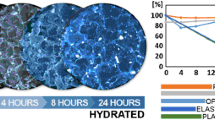Abstract
Characterisation and quantification of the surface energy of biomaterials used as tissue engineering scaffolds is important, but many of the techniques available to examine these properties are only applicable to smooth flat samples, not porous materials. This paper describes the application of the Washburn equation to measure the surface energy of a range of porous polyether polyurethane scaffolds with three test liquids; n-Hexane was used to measure a material constant, whilst ethanol and xylene were used to measure contact angles. The results show that the Washburn equation is not applicable in its current form, reasons for this could be that the voids in the materials are too wide for effective capillarity; absorption of the solvents into the polymer matrix may further complicate the measured imbibition profile. Another possible reason is the differences between the sizes of the interconnecting pores in scaffolds with varying void sizes; this could affect the capillary effect of the test liquids through the material. The repeatability of the results and the similar patterns observed with the different liquids suggest that if these issues could be quantified and incorporated into the Washburn equation, it may be possible to generate useful results for similar materials.
Similar content being viewed by others
References
J. D. Andrade, in “Surface and Interfacial Aspects of Biomedical Polymers, Vol. 1: Surface Chemistry and Physics” (Plenum Publishers, New York, 1985) p. 272
F. Rupp, D. Axmann, C. Ziegler and J. Geisgerstorfer, J. Biomed. Mater. Res. 62 (2002) 4.
S. Agathopoulos and P. Nikolopoulos, ibid. 29 (1995) 4.
E. W. Washburn, Phys. Rev. 17 (1921) 3.
E. Chibowski and L. Holysz, J. Adhes. Sci. Technol. 11 (1997) 10.
A. Hamraoui and T. Nylander, J. Colloid Interfac. Sci. 250 (2002) 60.
L. Zhaohui and R. F. Giese, J. Am. Ceram. Soc. 77 (1994) 8.
J. Troger, K. Lunkwitz, K. Grundke and W. Burger, Colloids Surf. A: Physcochem. Eng. Aspects 134 (1998) 299.
J. Schoelkopf, P. A. C. Gane, C. J. Ridgeway and G. P. Matthews, ibid. 206 (2002) 445.
Y. W. Yang, G. Zografi and E. E. Miller, J. Colloid Interfac. Sci. 122 (1988) 24.
Y. W. Yang, G. Zografi and E. E. Miller, ibid. 122 (1988) 35.
A. Siebold, A. Walliser, M. Nardin, M. Oppliger and J. Schultz, ibid. 186 (1997) 60.
“CDCA-100 Manual” (Camtel Ltd, Royston, UK, 1999) Appendix 2.
Author information
Authors and Affiliations
Corresponding author
Rights and permissions
About this article
Cite this article
Jackson, P.V., Hunt, J.A., Doherty, P.J. et al. Hydrophilicity of 3-D biomaterials: The Washburn equation. Journal of Materials Science: Materials in Medicine 15, 507–511 (2004). https://doi.org/10.1023/B:JMSM.0000021129.60818.ca
Issue Date:
DOI: https://doi.org/10.1023/B:JMSM.0000021129.60818.ca




